Nothing is more personal than a hand made quilt or doily. There is a personality to hand made rugs and quilts that cannot be duplicated by machine. Dempsey feels a particular connection with those who create anything by hand. It takes hours and hours of concerted effort as well as skill and a dream to create a patchwork quilt, or a crocheted doily, or a woven rug. It is the same kind of skill and commitment that it takes to create a watercolor painting. Birds of a feather.
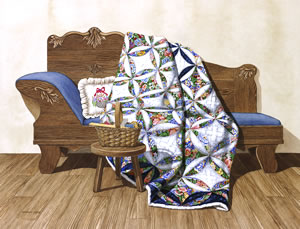
$120
"Robbing Peter to Pay Paul"
From the very beginning of his artistic career Dempsey Essick has drawn his inspiration from the land and the people he has grown up with and loves. His love of things hand crafted is reflected in his latest painting which features a patchwork quilt which is made in an old pattern called "Robbing Peter to Pay Paul." The design dates back many years and is expressed beautifully by the mother/daughter team of Ruby Craver Cook and Lou Ann Barker both of Welcome.
It is always a joy to meet people who love and cherish the patch of earth where they were born and where their parents and grandparents going back many generations, were born and lived. These are the people who are sometimes called "The Salt of The Earth." They are the rock solid, God fearing, hard working, people who made our country what it is.
Ruby Craver and Lou Ann Barker have their feet planted firmly in the soil of northern Davidson County, NC. Ruby is Lou Ann's mother. She is also a direct descendent of John Davidson Craver who was one of the earliest pioneers to settle in what is now Davidson County, North Carolina. Ruby worked the farm when she was small. She could do everything from tending the cows to making soap in a wash pot with hog grease and Red Devil Lye.
Lou Ann grew up with an artistic flair that is invaluable when selecting fabrics, colors and patterns for one of the couple's many quilts. The two have made over 50 quilts the old fashioned way using homemade templates made from cereal boxes to cut out the hundreds of pieces and hand stitching with the quilt on a frame just like in the old days.
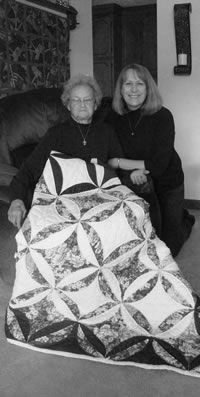
Ruby Craver Cook and Lou Ann Barker
Lou Ann Cook Barker Remembers
My mother (Ruby Craver Cook) and I have quilted together for twenty-five years. Some of our first quilts together were what are called “lap quilts”, this means that they were stitched on the quilters lap without using a frame. After finishing some “lap quilts” we began quilting with frames in my basement. We have made many precious memories together as we sit beside the wood stove in the winter, bonding and sharing stories. My mother and I have quilted over 50 quilts together.
Mom was born in 1926, and grew up on a farm on Craver Road. Her parents (Manie & Oma Craver) raised her to be a loving and hard working woman. She grew up during the depression and the countless memories of her life stories would always amaze everyone in the family. Her mother was a quilter and the love for the craft was passed on. Grandmother loved embroidery and crocheting also [mom embroideries and I crochet] and like her we like to stay busy.
My first quilt was started when I was 12 and finished when I was around 35. The quilt top was sewed on the sewing machine onto little pieces of paper that formed a star. Mom helped me and showed me this technique. Of course being only 12 years old I lost interest in the quilt top and never thought about it till I was around 35. When I asked my mother about the quilt top she knew exactly where it was. She had placed the squares in one of my suitcases that was made for baby doll clothes. As I counted the squares I only had 19, so mom made the final square for me and we completed my first quilt. My first quilt is so special to me because it represents the love a mother has for her child, and also the love for her grown daughter.
Our quilt frames were made by my brothers. They are made of pecan wood. My oldest brother, Ronnie Garrison, cut the frame out of lumber from a saw mill he was running at the time. My youngest brother, Freddie Cook, cut the holes in them. We had the frames for many years before we ever used them. My oldest brother is now deceased which makes the frames so special to mom and I knowing he made them for us.
The quilt featured in the painting “Robbing Peter to Pay Paul” was completed about 10 years ago. The pattern came from one of my Mom’s countless quilt books. I cut the quilt top out of fabric and sewed it together. We quilted it together in my basement on our quilt frames. I cherish every quilt we made together, but most of all I cherish the time and memories made with my mother.
For his painting, Dempsey has created a very simple setting reminiscent of a farm home of the 1930's. He has draped the "Robbing Peter to Pay Paul" quilt across an old wooden day-bed that belonged to his great-grandfather, Artis Walser of Reedy Creek, and added a milking stool with Lou Ann's sewing basket. The bare floors and simple surroundings are typical for a working farm in the days before central heat and electric lighting, days of hard physical labor and an abundance of warm family love.
Dempsey has captured each fold in the fabric and depicts every shadow in the scene so faithfully that the viewer might be tempted to reach out and touch the quilt or stroke the surface of the daybed. It is a scene of such peace and tranquility that the viewer can imagine curling up on the daybed on a rainy afternoon and snuggling under the soft quilt for an afternoon nap.
OKRA PICKLES
3 1/2 pounds small okra pods
1/3 cup salt
2 small hot peppers, cut in half
2 teaspoons dill seed
1 garlic bulb
1 quart water
1 pint vinegar
Pack okra firmly into hot jars, leaving 1/4 inch head space.
Put a garlic clove and half pepper into each jar.
Pour boiling brine to cover, leaving 1/4 head space.
Remove air bubbles.
Adjust caps.
Process 10 minutes in a boiling water bath.
Yield: about 4 to 5 pints.
"The highlight of this project was getting to know Ruby and her daughter Lou Ann. Ruby," Dempsey shared. "I delighted in Ruby's many recollections especially about churning butter in the new electric washing machine. Lou not only quilts but loves canning and gardening. It was her gift of a jar of pickled okra that sealed the deal for me. These are two very creative women and the skill goes back even another generation since it's Ruby's mother's embroidered pillow top that is featured in the painting too."
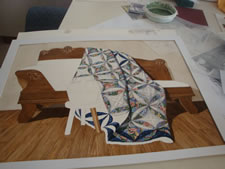
Painting in progress
Dempsey Shares
I had to use straight pins to secure a piece of paper and mark my place as I painted the quilt. The quilt pattern was very intricate as the same design was used in each square but faced different directions. As I studied the quilt I could see that Ruby and Lou Ann had taken great pains to make sure that each square was different but yet the same size.
In retrospect I would still rather paint the quilt than to stitch it.
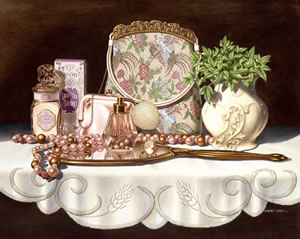
$75
"Lavender Sachet"
There is nothing like a few hours browsing at a flea market or an antique shop to give us a glimpse of how things were in another time. Old artifacts can evoke the fragrances, the look and the feel of times gone by. We catch a glimpse of an old brocade purse and think of the one grandma carried to church each Sunday. A silk evening bag alongside a string of pearls are reminders of a school dance.
Dempsey Essick and his wife, Shelley, recently spent a few hours in the Market Place Antique Mall in Winston-Salem, NC. Two employees who work there, Gail Yaroch and Kevin Beck, when they learned that the well known Lexington artist was looking for nostalgia items for a still life painting, were very helpful. In fact they were running around all over the place bringing items that Dempsey might use.
Dempsey has arranged the selected items casually atop a beautiful embroidered tablecloth. The ornate hand mirror, the perfume atomizer, a cameo pin, and a string of pearls randomly draped across the whole.
The handbag in the background is flanked by a vase with green leaves to remind of the present and a bottle of Lavender Sachet from which the painting derives its name.
At the height of his skills as a painter, Dempsey Essick does things with light and shadow that no one else currently working in the medium of transparent watercolor can match.
Lavender Sachet is one of those paintings that younger viewers can enjoy and come away with a feel for the atmospheres of times gone by. Older viewers can fall into a mood of quiet reflection, remembering.
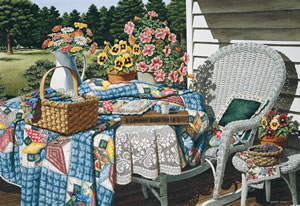
Sold out, unavailable
"Roxie's Touch"
Knowing how to sew was as essential as knowing how to cook for the colonial housewife. She hand sewed curtains, and slip covers, and most ofher family's clothing. Fabric scraps from her sewing, along with worn or outgrown garments, went into the scrap box to be used in patchwork quilts. A supply of quilts was a household necessity because the bedrooms were unheated.
It is a reflection of the pioneer spirit that the early homemakers would create designs that raised their quilting to the status of an art form.
The central focus of Dempsey Essick's new painting is a quilt in the Nosegay pattern made by Roxie Wofford, an expert quilter, from Southmont, North Carnllna. The Nosegay pattern is derived from the Flower Vase and Bridal Bouquet patterns created in the 1800's and first published in a magazine in 1933.

Dempsey with Roxie outside her Southmont home
"Roxie's Touch," presents a typical scene of a quilt -m-progress. Roxie has just stepped out of the picture leaving her basket of fabric scraps, a tobacco box {or razor blades and scissors, and her pincushion. All of which seems to say that she plans to return soon.
Bunches of flowers, or nosegays, along with a basket of MId blackberries, placed in the strong cross light of the morning sun, gives the feel of summer to the scene.
The fine detail in "Roxie's Touch," is unmatched by anything else Dempsey Essick has painted. The picture represents an enormous expenditure of time to accomplish the realism in each woven strand ofwickerwork, each fold and stitch in the quilt, and a lace tablecloth that appears to move in the breeze.
Viewers will find themselves stopping or slowing down each time they pass "Roxie's Touch" as each item in the picture asks for closer inspection.
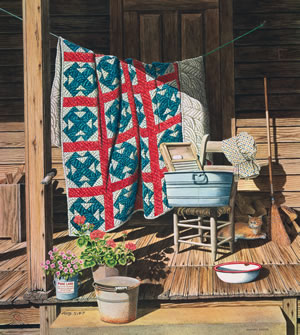
Sold out, unavailable
"Miss Jane's Wash Day"
At the end of a short dirt road in Iredell county, North Carolina, almost hidden in the trees, thereis a weathered grey farmhouse with a tin roof and a well in the side yard. It was here that Dempsey Essick found the scene pictured in "Miss Jane's Washday". Miss Jane, the owner of the house, is devoted to the simple, uncomplicated life of bygone days. She draws drinking water from her well and she washes her clothes by hand, just as her mother and grandmother did. Because she prefers to avoid the attention that accrues to subjects of Essick's paintings, Dempsey has honored her request to use only her middle riame in all references to "Miss Jane's Washday".
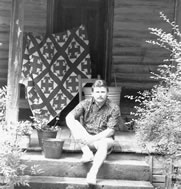
Dempsey
The focus of the picture is a galvanized number ten (10) washtub which uses an old cane-bottomed chair for a support. The everyday plainness of the tub is contrasted with a beautiful capital-T pattern quilt which is crosslit by the sun to show every fold and the fine hand stitching of Miss Jane's grandmother. The viewer's eye then picks out all the other details which make the painting a frozen moment in time. There is a chipped enamel pan, a bucket for catching rainwater, flowers in a lard tin, a date sratched in the concrete steps, the broken stub of a banister, and taking refuge in the shade besidea straw broom, Miss Jane's constant companion, a yellow cat named "Him."
With "Miss Jane's Washday", Dempsey has captured a scene that was commonplace in the rural south of sixty years ago, before automatic washers and dryers. The realism of his paintings, from the rusty nail heads to the folds in the quilt and sunbonnet give his work a depth that draws the viewer inside the frame to become a part of the picture.

Sold out, unavailable
"Special Ladies"
Because of their singular quality of being forever young, Dempsey Essick has chosen dolls to represent three ladies who occupy a special place in his life.
Sallie Parnell, Alice DeLapp and Irena McCormick inspired Dempsey's successful reproductions of From Aunt Sallie's Loom, Good Morning Miss DeLapp and Springtime at Irena's. With Special Ladies, he culminates the series with a tribute to the energy and youthful spirit of the three whose combined age is over 289 years.
A shaft of early autumn sunlight through Dempsey's studio window highlights a family heirloom rocking chair and brings out the textures in Aunt Sallie's hand loomed rag rug, the color in the pert straw hat on the doll that Santa delivered to Alice DeLapp over seventy years ago, and the intricate stitchery of the cathedral quilt and embroidered doily made by Irena McCormick. The bright-eyed doll wearing the split bonnet and the red-haired rag doll were supplied by two other Special Ladies - Dempsey's wife, Shelley and daughter, Beth.
As in other Dempsey Essick paintings, the viewer can almost feel the weave of the fabrics, stroke the smooth wood of the chair and sense the warmth of the afternoon sun.
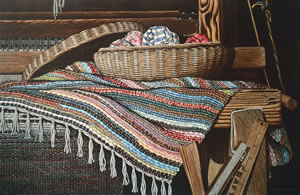
Sold out, unavailable
"From Aunt Sally's Loom"
When I started my art career back in the 1980s, one of my earliest paintings was of a hand-loomed rug made by a remarkable 101-year-old lady named Sallie Parnell.
Aunt Sallie, as she was known by thousands of people, touched many lives, not only through her rag rugs but also by her smile, her work ethic, her hope and perseverance. She lived her entire life in Tyro and made rag rugs on her 200-year-old loom. She would spend hours upon hours at the loom weaving. Her place of business was in the back of her house where she received customers/friends because if you were a customer, you were a friend. When you knocked on the door, she would say, "C'mon in." She never met a stranger.
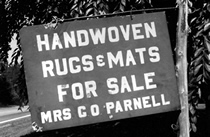
Aunt Sallie's mother taught her to weave when she was a little girl, and she did so up until her death. In trying to put Aunt Sallie into perspective it helps to remember that she was a woman of the '80s. Born in 1887, she lived her entire 107 years in the white, two-story frame house on N.C. Highway 150 in the community of Tyro here in Davidson County. The loom where she worked daily was built at about the time George Washington was inaugurated. The log barn behind her house was built by her grandfather before he went off to fight in the Civil War. Her father built the house where she lived just five years after Edison developed the electric light. Aunt Sallie's mother, Josephine, started teaching her to weave on the big, double harness loom that dominated one room of their home at about the time Teddy Roosevelt and the Rough Riders were making their charge up San Juan Hill. Man learned to fly and went to the moon while her shuttle passed countless times through the warp.
Sallie Farabee married George Parnell the same year that World War I started in Europe. Sallie and George were farmers, but the income from the weaving helped to keep body and soul together through the Great Depression and the birth of three boys and two girls.
The lowest point in Aunt Sallie's life came during World War II. The boys, Douglas, Terry and Frank, went into the service. Carolyn went into nurse's training, and Sarah stayed home to help on the farm. One day in 1945 she got a telegram that Douglas had been wounded in Germany. Just a week later she got another telegram that Terry had been killed in the Philippines. Later that year, a nephew, Major Thomas Farabee, released the atomic bomb on Hiroshima, and the war ended. When Douglas and Frank came home they only had a few months to get reacquainted with their father before he died in 1946.
I saw in Aunt Sallie truths that are timeless, truths such as hard work. She came from a generation that worked hard just to get by. Weaving rugs was very hard work, and it took many hours just to finish one drugget (full floor cover) or stair runner but, for her generation, if you did not work you did not eat. Her perseverance was a character trait that showed even when she was much older and had to use a walker to get to the loom. She kept weaving right up to her death at the age of 107.
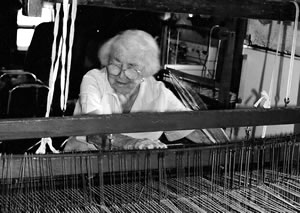
Aunt Sally at her loom on her 106th birthday
Aunt Sallie had a dry wit and sense of humor. I spent many hours just sitting, talking and laughing. I asked her once how she managed to live so long. She had heard that question many times, but she seemed to take a bit of extra time to answer me. Then she said, "Eating sweets," and I had to laugh. Her daughter, Carolyn, who lived next door and looked after her, had told me that it was an ongoing contest to try to find where Aunt Sallie would hide her chocolate or candy bars that people would bring to her.
I cherish the rugs that Aunt Sallie made for me because they are the real things, not "authentic reproductions." I cherish them also because they bring back the memory of a wonderful little lady who lived her life to the fullest. And who knows, maybe eating candy is the way to a long and happy life.
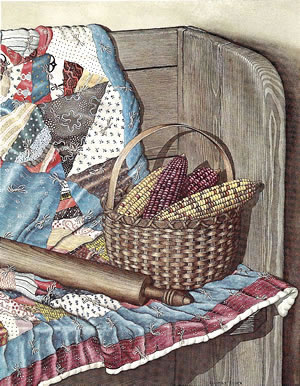
Sold out, unavailable
"A Taste of Country"
“A Taste of Country” brings to mind fond memories of tying quilting knots alongside Grandma.
Pictured here is a hand tacked, patchwork quilt from the early 1920’s. It gently rests across a worn deacon’s bench from an old black church in Sandersville, Georgia. Indian corn is nestled in a sixty year old basket once used to gather vegetables. A well used rolling pin adds the final touch to the country grouping.
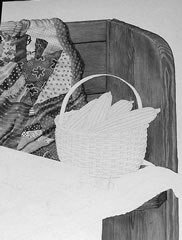
Dempsey painted the bench first
and then the quilt

The cover of "Our State" magazine
September 1989